ZYNODOA
A Y E A R B O O K



Shenandoah School of Music & Shenandoah Conservatory
Featuring
Images from the Shenandoah University Archives
Compiled by Kate Redding, piano technician
Acknowledgements
Preface
Our History
School of Music
The Musical Million
Piano Tuning Classes
Teachers
Students
Graduates By Year
Legend
Oh, Zynodoa
Piano Technology
Personal Stories
Alumni by Year
Enthusiasm & Self-Reliance
Class Prophecy
Humor
Advertisements
Piano Tech Timeline
To Kathy Evans, my friend in the library.
In appreciation of the resources given in support of this project
Shenandoah University
Shenandoah Conservatory
The Alson H. Smith, Jr. Library
The Library of Virginia
The Virginia Chronicle
The Dayton Exhibit
Charlotte Collins
David Hoffman
Tom Hunter
Eric Olson
Robin Olson
Paul Peak
Jerry Rodes
Kim Sator
Dale Smith

In the past, Shenandoah Conservatory was a destination for piano technology training and tradecraft. Early in my career, and newly employed with Jordan Kitt's Music, I had the chance to work with several experienced piano techs who were students of this program in the 1970s and 1980s
By the time I was hired at Shenandoah University in 2018, the piano technology program had mostly faded into memory However, one day while taking inventory of the piano shop, I stumbled upon a photo album that provided evidence of the program ' s success The album contained candid photos of students rebuilding a Schubert upright piano The last page of the album included a classified ad from the local newspaper listing the piano for sale, along with the names of its new owners. It was a fascinating glimpse into the past. I marveled at the snapshots, and set the album aside
Then in the autumn of 2021, I crossed paths with Kathy Evans at the Smith Library on campus. Kathy had made an exhibit of objects including a 1920 yearbook with the photo of the piano tuning department Recognizing my interest, she generously offered to share additional materials with me This was a stroke of luck To my surprise, the archives of Shenandoah University revealed that piano tuning was widely studied and practiced during the school's early years, between 1904 and 1931.
Based on my research using academic bulletins, yearbooks, journals, and personal accounts, this yearbook represents the story of piano tuning at Shenandoah Diving into the topic was tremendously enjoyable and will undoubtedly be a defining part of my Shenandoah experience. While I have made an honest attempt to be thorough, certain omissions are unavoidable. Please note that errors in this compilation are unintentional.
Now I present to you, this rendition of Zynodoa: Piano Tuning Teachers and Students of Shenandoah School of Music and Shenandoah Conservatory.
Kate Redding Winchester, Virginia,2023
"Shenandoah [Seminary] was organized at Dayton, Rockingham County, Virginia in 1875 with small attendance and unpretentious claims."
(1904 SCI Bulletin)

"Music and the [school] became so closely identified that in 1907 the institution was incorporated as the Shenandoah Collegiate Institute and School of Music. In order that it might broaden its scope of education, the music department was separately incorporated in 1937 as Shenandoah Conservatory of Music, and in 1942 it became a member of the National Association of Schools of Music " (1945 Zynodoa)
The 1940s and 50s were a difficult time for the financial stability of the college A second home for the school was chosen in Winchester, Virginia In 1958, ground was broken on the Winchester location, and in 1960, Shenandoah College and Shenandoah Conservatory of Music moved from Dayton to Winchester.
From its early years, the school embraced a policy of coeducation. However, Black students were prohibited from enrolling due to Virginia's segregation laws It was only after the implementation of the Civil Rights Amendment in 1964 that the college finally welcomed Black students
Today, Shenandoah University is one of the most notable private institutions in the Commonwealth of Virginia. In 2025, the university will celebrate its 150th anniversary.
"During all the years of the history of the school, the study of music has been encouraged"
"The origin of our School of Music was not in any sudden movement, but was the outcome of a feeling that a practical School of Music was needed. So many young people attend a School of Music and having completed a course return home, and if called upon to direct in a service of song, or preside at the organ in church, or conduct a choral society, appear at great disadvantage it not entirely unprepared " (1915 B)
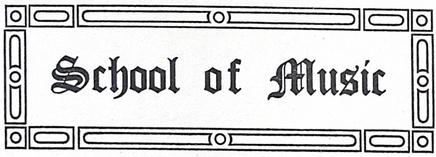
"While our school seeks to do all of the things that will make artists of our pupils, yet that practical work and training which is so essential in preparing young men and women to fill the many useful positions in the musical world of the day, is not overlooked. There is an ever-increasing demand for people who can do things. We offer the school where you can learn to do what the world wants done." (1915 B)
"The Conservatory of Music is equipped with more than twenty pianos including two grand pianos, and two Moller pipe-organs; one a two-manual organ and the other a four-manual, modern in every respect " (1931 B)
Recognizing the profound role of music in worship and the community, the institution dedicated itself to instilling an understanding of this musical discipline Students were provided with training and guidance, equipping them with the necessary skills to sing, play the organ, and to lead music ensembles.

"You know about its advantages. You should attend."Moller Pipe Organ 1910 Zynodoa
The Musical Million was a "journal of music, poetry, and chaste home literature," published by the Ruebush-Keiffer Co , in Dayton, between 1870 and 1914

Advertisements for Shenandoah Collegiate Institute and School of Music were featured prominently in the pages of The Musical Million. This was an effective way for the school to market its educational opportunities directly to readers

Two of Shenandoah's earliest graduates, James and William Ruebush - both talented musicians and teachers - were frequent contributors to the journal. Each was instrumental in expanding Shenandoah's music curriculum.
Advertisements for piano tuning courses at the School of Music appear in other American magazines, including The Etude, and The Musical Observer.
Advertisement from The Etude, May 1927
Musical Million masthead, 1879."S.C.I. is the only school in the South that maintains a first-class Piano Tuning Department."

Musical Million, Volume 41, Number 2,
1 February 1910
"Largest Music School in the South. Students from Twenty States"

Musical Million, Volume 45, Number 11,
1 November 1914
"Rates are most reasonable."
Musical Million, Volume 35, Number 1, 1 January 1904
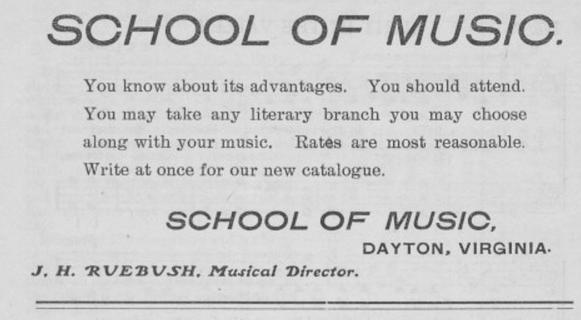
"Persons coming on the Southern or Baltimore & Ohio railroads should take the Chesapeake Western at Harrisonburg Junction. Persons coming on the Norfolk & Western should take the Chesapeake Western at Elkton " (1903 B)
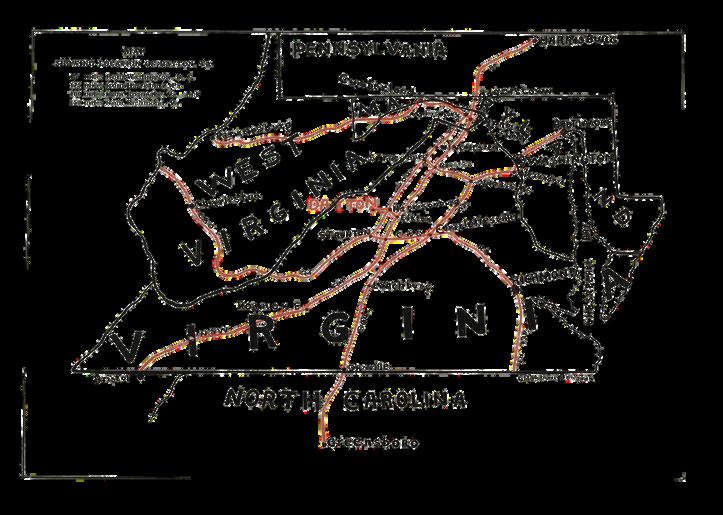

Located along the historic Great Valley Road, S C I attracted students from the Shenandoah Valley and beyond, including Pennsylvania, Maryland, West Virginia, Georgia, and the Carolinas. With its convenient proximity to train stations, the campus became easily accessible, opening its doors to aspiring learners from near and far
Map, 1913 Bulletin
Advertisement, 1911 Zynodoa
"This department is intended for those who desire to become piano tuners, and who have not the facilities to learn in a factory. Piano t i i f th f f i th t i t d d d
 1911 Zynodoa
1911 Zynodoa
Knowing the great demand throughout our country for competent piano tuners, and the remunerative possibilities in this profession, we were induced a few years ago to establish this department. It has proven a great success from the beginning. The great satisfaction our [tuners] have given the general public, combined with large financial returns arising from this vocation, has caused us to equip this department, and we are now able to offer the most thorough course of instruction (1908 Z)
Shenandoah's piano tuning students often transitioned into educators, providing piano tuning instruction, teaching multiple instruments and performing in ensembles at the school. The faculty consisted largely of alumni, embodying a home-grown tradition of education. With a rising demand for individuals capable of repairing pianos, the institution discovered a growing interest among both men and women.
 1914 Zynodoa
1914 Zynodoa
Ten people gather on stage for class Half the students crowd to watch an individual, possibly John Good, who stands at the grand piano keyboard on the right. On the left, students take turns tuning an upright piano.
John Good was an early tuning instructor at the School of Music

The 1910 Zynodoa provides a biography of his education and training Good served as a faculty instructor in Clarinet, Reed Instruments, and Piano Tuning.
 1910 Zynodoa
1908 Zynodoa
1910 Zynodoa
1908 Zynodoa
The piano tuning department gathers in a classroom with pianos in the background Action models are displayed on a table in the foreground Instructor Albert Hall, second from left, is pictured holding an open book.
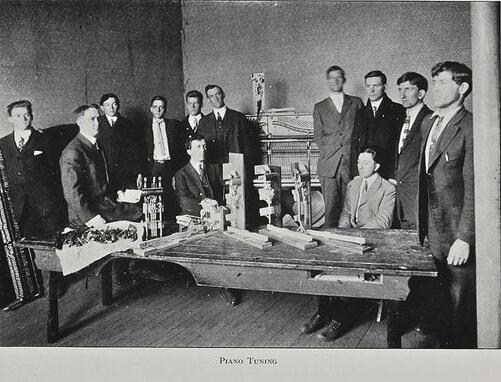
Albert Hall, a former student at S.C.I., graduated from of the Faust School of Piano Tuning in 1914
16 piano tuning students pose outdoors with tuning tools and action models.
 1915 Zynodoa
1916 Zynodoa
1915 Zynodoa
1916 Zynodoa


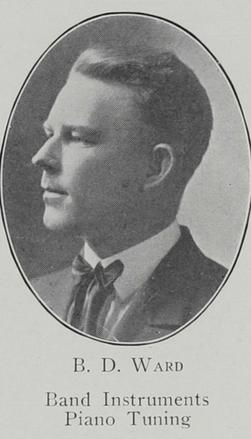



 Piano Tuning Teachers 1904 - 1931
John M. Good 1904 - 1913 1914 - 1916
Albert A. Hall
W.E. Dye 1920
1923, 1929 - 1931
Walter B. Judy
B.D. Ward
Frank Snoddy 1917 1922
Emory G. Burton 1928
Piano Tuning Teachers 1904 - 1931
John M. Good 1904 - 1913 1914 - 1916
Albert A. Hall
W.E. Dye 1920
1923, 1929 - 1931
Walter B. Judy
B.D. Ward
Frank Snoddy 1917 1922
Emory G. Burton 1928


Raleigh, North Carolina
Music Teachers' Course, Piano Tuning, 1909
"Nature has endowed him with a musical voice and energy to keep pressing ever onward."
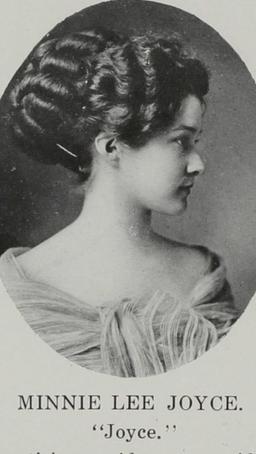
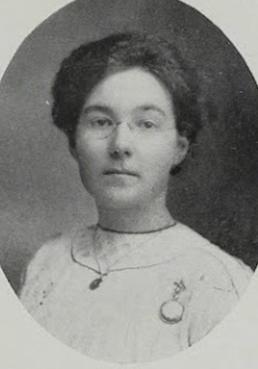
Stoneville, North Carolina
Piano, Piano Tuning Course, 1911
"She is full of life and fun."
Piano Tuning Certificate, 1911
"Be not deceived by her quiet mien. We look to Eva to paint the future with glowing deeds "
Piano Tuning, 1912
"He is very successful in athletics and especially on the diamond "


Seaboard, North Carolina
Piano Tuning, 1913
"We wish this coming 'Caruso' much success. "
Simpsonville, South Carolina
Piano Tuning, 1914
"Not a student in school has more friends than Sloan "
Leaksville, North Carolina
Piano Tuning, 1915
"Luther has been a diligent student at SCI, and is never happier than when in an argument "
Simpsonville, South Carolina
Vocal Music Teachers' Course, 1915


Piano Tuning, 1916
"None but himself can be his parallel "
For many years, tuning has been looked on as being an occupation of low rank, but the people of today are coming to know and realize the importance of a well-tuned instrument. Those who love and appreciate perfect music should also love the art of tuning.
After several months of careful study, we have learned to love and appreciate perfect music more fully. (1920 Z)
Business card of Chester B Funkhouser, 1920 graduate
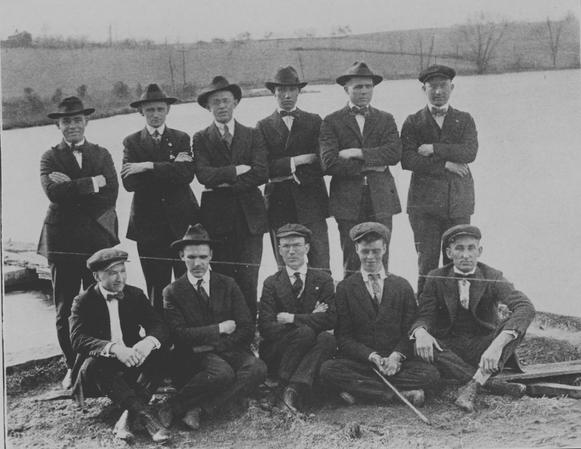
 Piano Tuning Department, 1920
Piano Tuning Department, 1920
Mt. Jackson, Virginia
Piano Tuning, 1920
"Chester is an all around good fellow."




Blacksburg, South Carolina



Piano Tuning, 1920
"He has made friends among a number of students and faculty."
Joe Bryant
Blue Springs, Mississippi
Piano Tuning, 1920
"Here is our class poet."
Westminster, South Carolina
Piano Tuning, 1920
"When it comes to playing the piano, Butts is there."
Athens, Georgia
Piano Tuning, 1922
"He is quiet but is game for a joke whenever one comes his way. "

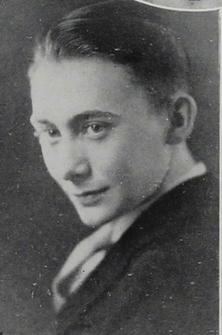


East Liverpool, Ohio
Classical Course, Piano Tuning, 1922
"He is long in stature, and long in getting started, but once started, look out!"



Berkeley Springs, West Virginia
Post-Graduate Expression, Piano Tuning, 1928
"Most talented Everybody's pal "
Harrisonburg, Virginia
Church Music, 1960
He gained a reputation for his perfect pitch, and tuned all the pianos
1904
William M Spessard, Chewsville, Md
1905
Henry C Stringer, Bay Springs, Ms
1906
Thomas Newton Benton, Timmonsville, SC
William A Flick, Mt Clinton, Va
George W. Lassiter, Branning, NC
Oscar Massey Lee, Fairfield, Va.
1907
G W Brewington, Spartanburg, SC
Dayton S Hoover, Crouse, NC
W Talmage Merritt, Easley, SC
Charles W. Moore, Mountain Lake Park, Md.
Julius S. Rushing, Stage, Ms.
James Franklin Stevens, Wesson, Ms
McDuffy Weams, Central, SC
George Q Wigington, Easley, SC
Homer A Weathersby, Agatha, SC
Perry Wriston, Dothan, WV
1908
Jasper Newton Barnett, Shelby, NC
Robert Clinton Boling, Greenville, SC
Lonnie Cleveland Davis, Milwaukee, NC
Albert F Guthrie, Evanwood, WV
Thomas Ogden Pender, Efland, NC
1909
Grover Cleveland West, Union, SC
Eugene McIntosh Cullom, Raleigh, NC
Jessie Madison Smith, Martin, Ga.
Robert Owen Dickson, Dayton, Va.
1911
David Weldon Ewing, Gerrardstown, WV
Karl Victor Brown, Daniels, WV
William Amos Jones, Easley, SC
Benton Mebane Pittard, Cedar Grove, NC
Marvin Leon McAdams, Siler City, NC
Minnie Lee Joyce, Stoneville, NC
Walter F. Hammer, Lynchburg, Va.
Demosthenes Cicero Blevins, Springfield, NC
Francis Lowe, High Point, NC
Elijah Cleveland Willis, Conehatta, Ms.
Eva Rexroad, Dayton, Va
Hollis Howe Keiter, Dayton, Va
John Wesley Ramsbottom, New Bedford, Ma
Clarence A Plummer, Laytonsville, Md
Carl Stoltz, Bethania, NC
Glenn Cline, Harrisonburg, Va.
1912
Lawrence J Caruthers, Tampa, Fl
Carl M. Davis, Swetnam, Va.
A. A. Hall, Spray, NC
1916
Sam Manning Snow, Simpsonville, SC
1917
O
M Huggins, Hendersonville, NC
H P Markwood, Blaine, WV
Walter Merkel, Syracuse, NY
W H Marion, Pinnacle, NC
John M. Myrick, Hattiesburg, Ms.
1913
Paul Shaver, Maurertown, Va.
Sam Braxton, Kinston, Va
Guy Britten, Seaboard, NC
1914
Emory Peck, Gainesville, Ga
Harold Stevens, Dundoff, Pa.
Grady Stewart, Simpsonville, SC
Lawrence Sloan Verdin, Simpsonville, SC
F F Calahan, Selbysport, Md
Estelle Smith, Houstonville, NC
Boyce Holtzclaw, Greer, SC
Jesse H. Rector, Mure, Ky.
Alice Best, Galvant’s Ferry, SC
John Craft, Anderson, SC
1915
Luther Calvin Hall, Leaksville, NC
Frank Snoddy, Mt. Airy, NC
1920
Joe Bryant, Blue Springs, Ms.
Thomas Jones, Chesnee, SC
Clarence Butts, Westminster, SC
Buford Moore, Blacksburg, SC
Chester Funkhouser, Mt Jackson, Va
1922
Ollie C Swords, Athens, Ga
Raymond Henry Peake, E Liverpool, Oh
1927
Paul Shepard, Gastonia, NC
1928
Donald Benton Somers, Berkeley Springs, WV
1931
Andrew James Fowler, Spartanburg, SC
Centuries ago, in the primeval forest of what is now the Valley of Virginia, there lived a beautiful songbird. Its sweetest song was sung at twilight, the time when day so beautifully blends with night The song which this bird sang was
One evening as a young mother was lulling her child to rest, a Zynodoa, perched nearby, poured forth its evening lay It sang as never before; its throat shook with rapturous trills, and the melody of it entered into the mother's heart

She named her little child Zynodoa.
Years passed; Zynodoa, became a great leader, and his fame spread.
At last, the Great Spirit called him, but he was not forgotten.
As a memorial to the beauty, strength, and the bravery of his life, his people gave his name to the river, mountain, and the valley which we now call Shenandoah
"Zynodoa, Zynodoa."
The name Shenandoah is said to have originated from the Native American legend of Zynodoa, a chief known for his strength, courage, and appreciation of beauty As a fitting tribute, students of Shenandoah Collegiate Institute and School of Music called the inaugural edition of their yearbook "Zynodoa" in 1909

Today, the university embraces an interpretation of Shenandoah as "Daughter of the Stars." Consequently, stars are frequently portrayed on Shenandoah University emblems, artistic creations, and mentioned in its communications.
According to this origin story, when the Great Spirit created the morning stars, the celestial beings gathered in song, their light reflecting in the waters of a beautiful silver lake One morning, a great tremor shook the mountain, creating a deep fissure, and the waters of the lake surged forth towards the sea. Some time later, the stars set out to find another place to convene and discovered a picturesque valley with a meandering river. Recognizing that this valley had once cradled their lake and was surrounded by the same blue mountains, the stars cast the jewels from their crowns into the river, bestowing it with eternal sparkle. This river and its valley became known as Shenandoah, the illustrious Daughter of the Stars
While these legends are inspiring, it is important to acknowledge that their credibility and origin remain unknown Scholars today believe that the name Shenandoah originates from three Native American names: the Senedo, an ancient people; the Shawnee name Cenantua; and the Iroquois name Sherando.
Illustration, 1915 Zynodoa
We affectionately call our school ShenCo.
Coinciding with the 100th anniversary of the college in 1975, a new curriculum in piano technology was established. In 1976, Shenandoah Conservatory began granting an Associate of Science in Piano Technology and a Certificate in Piano Technology.
The Associate of Science in Piano Technology curriculum prepares students for vocations as piano technicians The two-year curriculum includes all aspects of tuning, rebuilding, and refinishing The Certificate in Piano Technology contains the basic technical, tuning rebuilding, and refinishing courses, plus fundamental studies in piano, theory and accounting. (1981 B)
During this period, students at Shenandoah Conservatory continued the tradition of studying piano technology alongside disciplines such as performance, music education, church music, and business.

"Piano technology at [the] conservatory started in 1973 or 1974. Paul Schiller and Eric Hillman were tuning for Shenandoah and they would offer a class for 15 or 20 students At that time there were about 75 pianos in the inventory "
Employed as a piano tuning instructor from 1976 to 1978, Paul remembers inviting Wendell Eaton to conduct a class on campus Paul himself pursued higher education and achieved a Masters in Music Education, as well as a DMA in Voice, Conducting, and Church Music He continues to actively serve as a music minister, educator, and piano technician.
"I started lessons on piano at age 8 We had a blind piano tuner who came to our house, and I was fascinated that he couldn’t see, but he could touch and hear, and he could do it. When I was teaching, I had students do things blindfolded because some things you have to feel, like regulating the spoons There was a school for the blind in West Virginia that taught piano tuning I took my classes there to meet the teacher and students I got creative trying to get them to learn "
As a piano tech instructor at Shenandoah, Jerry organized field trips to the Smithsonian instrument storage room, and introduced students to player pianos, pump organs, and harpsichords Jerry is the 5th person in his family to attend Shenandoah.
"I started college life as a flutist, and completed the ASPT degree in 1979 I was always fascinated with aural tuning "
During his time as piano tuning instructor, David accompanied students on trips to Vienna, and Boston His contributions to Shenandoah University's instrument collection include the construction of a harpsichord and a forte piano David has dedicated over 35 years of service to Shenandoah University

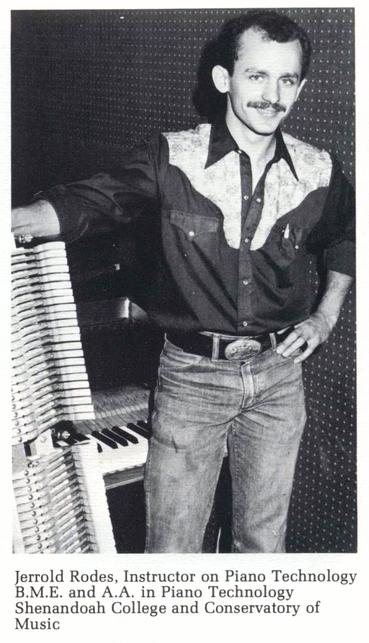

 Lyford - Hoffman forte piano
Wendell Eaton at Shenandoah, c 1977
Lyford - Hoffman forte piano
Wendell Eaton at Shenandoah, c 1977
"I came to Shenandoah Conservatory as a trombone major By my junior year, I was enrolled in the piano technology program The course load was 3 or 4 classes per semester: first year uprights, second year grands, and a summer rebuilding project. I looked forward to piano tuning. I vividly remember walking across the bridge with my toolbox to G&M Music and it really felt good I graduated in April of 1980, and started working for Jordan Kitts in December 1980."
"I attended Frederick Douglas High School in Baltimore which had a music careers curriculum. For 2 years straight, I spent afternoons with professional techs, worked full time, and I got paid I chose Shenandoah Conservatory specifically for the piano technology program, and I played trombone in ensembles."
"I started as a Music Education major, and harpist. I entered the College and Conservatory in the fall of 1978, At that time, I was part of the largest AfricanAmerican freshman class: about 35 people out of 800 I loved working with my hands The one thing I like about this field is it’s just about the work I felt like it was an equal playing field. As an African-American female, I was the only one. "
"It was frustrating trying to get someone to tune the pianos regularly The technician would come from D.C., and the roads were not nearly what they are now. Students would work wherever they could, in the lobby or the hallway. I recall what a big deal it was when they got a hoist to lift the piano plate My husband Verne and I both believed that piano technology was vital to all parts of the conservatory. There was general interest that we should grow our own piano techs if we could More utilitarian skills are needed "







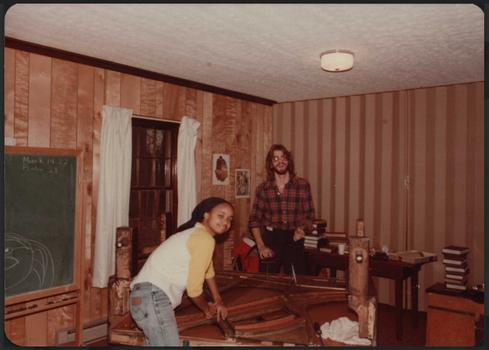



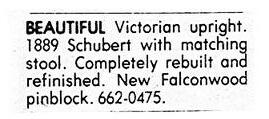
The Winchester Star, March 23, 1990
In a remarkable undertaking, 19-year-old student Matt Ellenberger constructed a forte piano modeled after one built by Johann Andreas Stein in 1784 The fruit of his labor was showcased in a concert held in March 1990, where his instrument took center stage

Matt was one of the last students to complete a piano technology degree at Shenandoah Conservatory. His forte piano remains in the collection of Professor Emeritus, Dr. Stephen Cooksey.
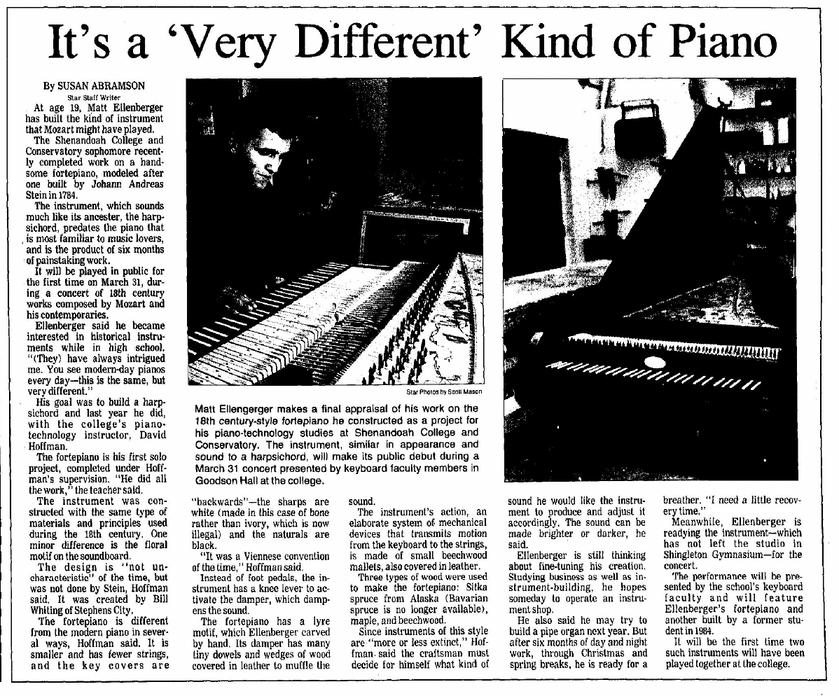
1976
Paul E. Peak
1977
David H. Frease
Jerrold N. Rodes
1979
Gerry Cousins
David Hoffman
Rick Jones
1980
Constance Megas
Steven Muller
Robin Olson
Dale Smith
1981
Richard Damon
Tom Naglee
Eric Olson
Kim Sator
Sally Seabright
1982
Lloyd K Gray
1983
Veronica Gacek
Dale Lassiter
1984
Robb Lasko
1985
Andrew J. Lyford
Howard T. Muir
1987
David P. Carlson
Brenda K. Miscavage
1988
Ralph L. Davis
Jonathan K. Svec
1989
Dick J. Petersen
Robert B. Thurnburgh
1990
Frederick W. Riley
Peter Stumpf
Charles Johnson
Connie Mead
Randy Milgraum
1991
Howard P Jones
Lars G Novang
1992
Matt Ellenberger
merson said "Nothing great was ever accomplished without enthusiasm," and it is true in every respect. Since the dawn of history, enthusiasm has been one of the greatest assets known for the accomplishment of all great purposes.
We may possess an almost inexhaustible supply of information, yet without putting forth the necessary amount of enthusiasm we can never do to the fullest what we would like to do or what we are capable of doing. Self-reliance, coupled with enthusiasm for the work, ensures the result

In whatever we undertake if we wish to meet with success, these two things are certainly necessary: If we wish to keep pace with others who are probably less fitted for their work than we are, we must be sure that we are self-reliant and enthusiastic in whatever we undertake -
Hazel C Hamrickn the midst of a pandemic-induced silence, a hush fell upon the music building. The usual symphony of laughter and applause had faded, leaving behind empty concert halls and vacant classrooms. The only sound that broke the eerie quiet was the plaintive song of a solitary piano tuner, seeking solace in her craft
Longing for an escape from the confines of her workroom, the tuner ventured towards the campus library Little did she know she was destined to uncover something wonderful As she stepped into the library, a figure emerged from the shadows a guardian of history also known as an archivist
With a twinkle in her eye, the archivist guided the piano tuner through the labyrinthine stacks, unveiling a wellspring of knowledge from years long past The photographs of tuners from bygone eras adorned the carefully preserved pages, their names and faces reflected through a distant mirror Among the cherished relics was the tuning fork of a beloved teacher and musician - James Ruebush - the backbone of Shenandoah
When it was struck, the tuning fork hummed gently, casting its spell over the piano tuner An enthusiasm to shed light on this forgotten heritage grew within her. Inspired by this encounter, she set out to celebrate the legacy of piano tuning at Shenandoah and document the narratives of those who pursued the craft of piano tuning in this place before her.
As the pandemic quarantine lifted, students returned to campus, and laughter, song, and applause once again filled the halls of the music building. But the piano tuner did not forget what she had learned Through this yearbook, the world would come to know the countenances of piano tuning students and teachers, and their contributions, forever a part of the pursuit of beauty and music at Shenandoah
So, this piano technician walks into a fancy music school, ready to bring the pianos back to life. The head instructor looks at the technician, all serious and says, 'We need that piano to sound so incredible, it'll make Beethoven himself jump out of his grave!' The tech, with a twinkle in her eye, replies, 'Well, I can't promise a miracle, but I can make it sound good enough Für Elise.'
I once knew a piano tuner who had quite the knack for his craft He'd go from house to house, fixing those ivory ticklers But one day, he gets a call from a client who says, 'My piano sounds awful, it's all out of tune!' So, the piano tuner goes over there, plunks a few keys, and says, 'Well, I found the problem. You got a nest of mice living inside your piano!' The client looks shocked and asks, 'Mice? How do you know?' The tuner grins and says, 'Well, when I played the keys, I heard them squeaking, 'We're flat, we ' re flat!' It was a critter symphony, right there in the living room!

Have you ever noticed how piano tuning is like the ultimate precision job? These tuners are like the surgeons of the musical world They come in with their little tools and their sharp ears, trying to make those strings vibrate in unison. And you know what? It's a tough gig if you think about it. You're dealing with one instrument, but all of the notes!
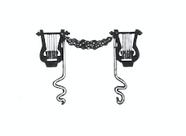




1904-1910
Coinciding with the boom in American piano production, Shenandoah Collegiate Institute and School of Music offers a course in piano tuning The cost of the course is $50 00 William Spessard of Maryland is the first documented graduate in 1904.
1911-1916
The demand for people who can tune and repair pianos continues to attract students to the course The number of graduates reaches about 75. The school is a leader in educating piano tuning students in the American South.
1917
War in Europe disrupts life in the Shenandoah Valley as young men join the service. The Flu pandemic of 1918 occurs, but "not one student was lost to Flu," reports J H Ruebush Several legally blind students complete the piano tuning course During this time the school receives multiple accreditations from the State Board of Virginia. Meanwhile, the college moves away from its piano tuning program as it attracts fewer students to the course
Coinciding with the institution's 100th anniversary in 1975, Shenandoah Conservatory begins offering a 2-year Associate of Science Degree (ASPT) and a 1-year Certificate in Piano Technology Major piano rebuilding projects are completed around this time.
The program continues with the support of the conservatory's leadership Students are offered courses in acoustics, repair, tuning, regulation, rebuilding, and refinishing Class projects, and individual projects are completed including harpsichord, and forte piano building.
Shenandoah College and Conservatory officially becomes Shenandoah University on January 1, 1991. It becomes harder to enroll piano tech students who can the meet the university's admissions requirements Declining interest, coupled with insufficient dedicated space, compounds the difficulty of sustaining the program.
 Illustration, 1911 Zynodoa
Illustration, 1911 Zynodoa
